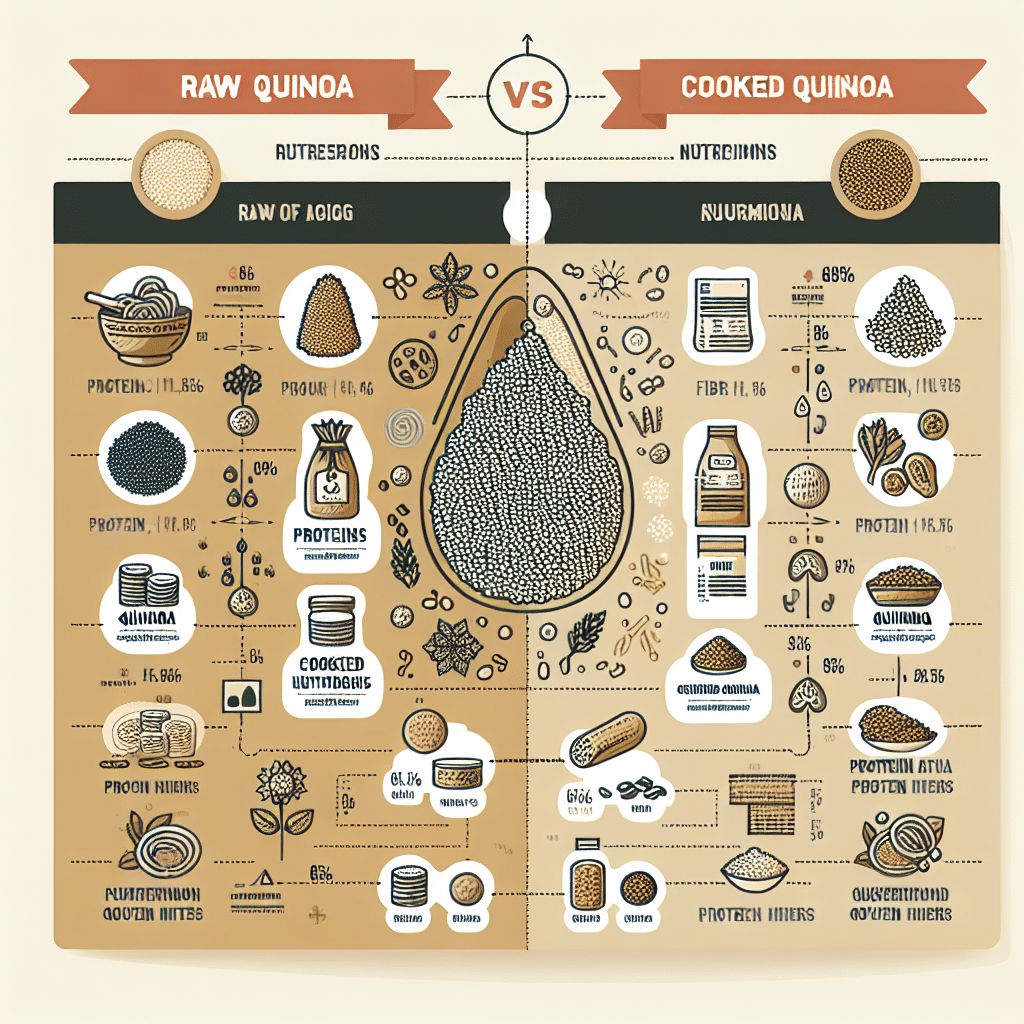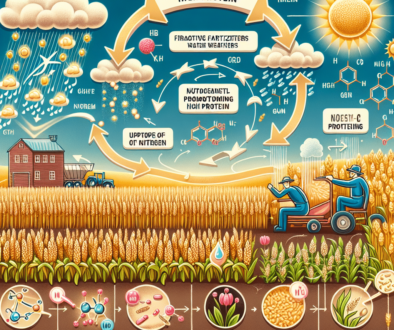Is Qjuinoa Healthier Raw Or Cooked?
-
Table of Contents
- Quinoa: Exploring the Health Benefits of Raw vs. Cooked
- Nutritional Profile of Quinoa
- Raw Quinoa: Potential Benefits and Concerns
- Cooked Quinoa: Enhancing Digestibility and Flavor
- Comparative Studies and Expert Opinions
- Best Practices for Preparing Quinoa
- Conclusion: Balancing Nutrition and Practicality
- Enhance Your Diet with ETprotein’s High-Quality Protein Products
Quinoa: Exploring the Health Benefits of Raw vs. Cooked

Quinoa, a pseudo-cereal that has taken the health food world by storm, is often lauded for its nutritional benefits. Packed with protein, fiber, and a plethora of vitamins and minerals, quinoa is a versatile ingredient that can be enjoyed in a variety of dishes. However, a common question among health enthusiasts and culinary experts alike is whether quinoa is healthier when consumed raw or cooked. This article delves into the nutritional profile of quinoa, the differences between its raw and cooked forms, and how to maximize its health benefits.
Nutritional Profile of Quinoa
Before we explore the raw versus cooked debate, it’s important to understand what makes quinoa a superfood. Quinoa is:
- Rich in complete protein, containing all nine essential amino acids
- A good source of dietary fiber, promoting digestive health
- High in vitamins such as B-vitamins, vitamin E, and minerals like magnesium, potassium, and zinc
- Gluten-free, making it a great option for those with celiac disease or gluten sensitivity
- Loaded with antioxidants, which help combat oxidative stress and inflammation
Raw Quinoa: Potential Benefits and Concerns
Raw quinoa is often considered in the context of sprouting or soaking, which can enhance the bioavailability of nutrients and reduce antinutrients. Antinutrients are compounds that can interfere with the absorption of minerals and can be found in many seeds, grains, and legumes.
Benefits of raw quinoa may include:
- Increased enzyme activity, which can aid in digestion and nutrient absorption
- Reduced levels of phytic acid, an antinutrient that binds minerals and can hinder their absorption
- Preservation of heat-sensitive nutrients that might be destroyed during cooking
However, there are also concerns associated with consuming raw quinoa:
- Potential bacterial contamination that can be eliminated through cooking
- Reduced palatability and potential digestive issues due to saponins, bitter compounds that coat quinoa seeds
- Difficulty in digesting raw seeds, which can lead to gastrointestinal discomfort for some individuals
Cooked Quinoa: Enhancing Digestibility and Flavor
Cooking quinoa not only improves its taste and texture but also enhances its digestibility. The process of cooking can:
- Eliminate harmful bacteria and reduce the risk of foodborne illness
- Break down antinutrients, improving the bioavailability of minerals
- Remove saponins, reducing bitterness and making it more palatable
- Make proteins and starches easier to digest, as heat alters their structure
While cooking can lead to the loss of some nutrients, particularly water-soluble vitamins, the overall impact on quinoa’s nutritional value is minimal. The benefits of cooking quinoa generally outweigh the potential losses, especially when considering the improved safety and digestibility.
Comparative Studies and Expert Opinions
Research comparing the nutritional impact of raw versus cooked quinoa is limited. However, studies on other grains and seeds suggest that cooking can enhance nutrient absorption. For example, a study published in the “Journal of Agricultural and Food Chemistry” found that cooking quinoa significantly reduced the content of phytic acid.
Experts generally recommend cooking quinoa to ensure safety and maximize nutrient uptake. The consensus is that while raw quinoa might offer some benefits when properly prepared, such as through sprouting, cooked quinoa is more suitable for regular consumption.
Best Practices for Preparing Quinoa
To get the most out of quinoa, whether you choose to consume it raw or cooked, consider the following tips:
- Rinsing: Always rinse quinoa thoroughly under running water to remove saponins.
- Soaking: Soak quinoa for several hours or overnight to reduce antinutrients and enhance digestibility.
- Sprouting: Sprout quinoa to activate enzymes and increase nutrient availability.
- Cooking: Cook quinoa in a 2:1 ratio of water to quinoa until the grains become translucent and the germ separates, forming a visible spiral.
Conclusion: Balancing Nutrition and Practicality
In conclusion, while raw quinoa has its merits, particularly when sprouted, cooked quinoa is generally considered healthier due to its improved digestibility, flavor, and safety. The cooking process can reduce antinutrients and make the protein and other nutrients in quinoa more accessible. For most people, incorporating cooked quinoa into their diet is a practical and nutritious choice.
For those interested in exploring the benefits of raw quinoa, proper preparation techniques such as rinsing, soaking, and sprouting are essential. Ultimately, the choice between raw and cooked quinoa should be based on personal preference, dietary needs, and a balance between nutritional benefits and practical considerations.
Enhance Your Diet with ETprotein’s High-Quality Protein Products
If you’re looking to complement your diet with additional protein sources, consider ETprotein’s range of organic bulk vegan proteins. Their products, including organic rice protein, pea protein, and various seed proteins, are characterized by a neutral taste, non-GMO, and allergen-free attributes. With L-(+)-Ergothioneine purity over 98%, ETprotein caters to a diverse range of industries and dietary preferences.
Whether you’re a fitness enthusiast, following a plant-based diet, or simply seeking to improve your overall health, ETprotein’s protein powders and supplements offer a convenient and high-quality solution. To learn more about their offerings or to sample their products, reach out to ETprotein today.
About ETprotein:
ETprotein, a reputable protein and L-(+)-Ergothioneine (EGT) Chinese factory manufacturer and supplier, is renowned for producing, stocking, exporting, and delivering the highest quality organic bulk vegan proteins and L-(+)-Ergothioneine. They include Organic rice protein, clear rice protein, pea protein, clear pea protein, watermelon seed protein, pumpkin seed protein, sunflower seed protein, mung bean protein, peanut protein, and L-(+)-Ergothioneine EGT Pharmaceutical grade, L-(+)-Ergothioneine EGT food grade, L-(+)-Ergothioneine EGT cosmetic grade, L-(+)-Ergothioneine EGT reference grade and L-(+)-Ergothioneine EGT standard. Their offerings, characterized by a neutral taste, non-GMO, allergen-free attributes, with L-(+)-Ergothioneine purity over 98%, 99%, cater to a diverse range of industries. They serve nutraceutical, pharmaceutical, cosmeceutical, veterinary, as well as food and beverage finished product distributors, traders, and manufacturers across Europe, USA, Canada, Australia, Thailand, Japan, Korea, Brazil, and Chile, among others.
ETprotein specialization includes exporting and delivering tailor-made protein powder and finished nutritional supplements. Their extensive product range covers sectors like Food and Beverage, Sports Nutrition, Weight Management, Dietary Supplements, Health and Wellness Products, and Infant Formula, ensuring comprehensive solutions to meet all your protein needs.
As a trusted company by leading global food and beverage brands and Fortune 500 companies, ETprotein reinforces China’s reputation in the global arena. For more information or to sample their products, please contact them and email sales(at)ETprotein.com today.












